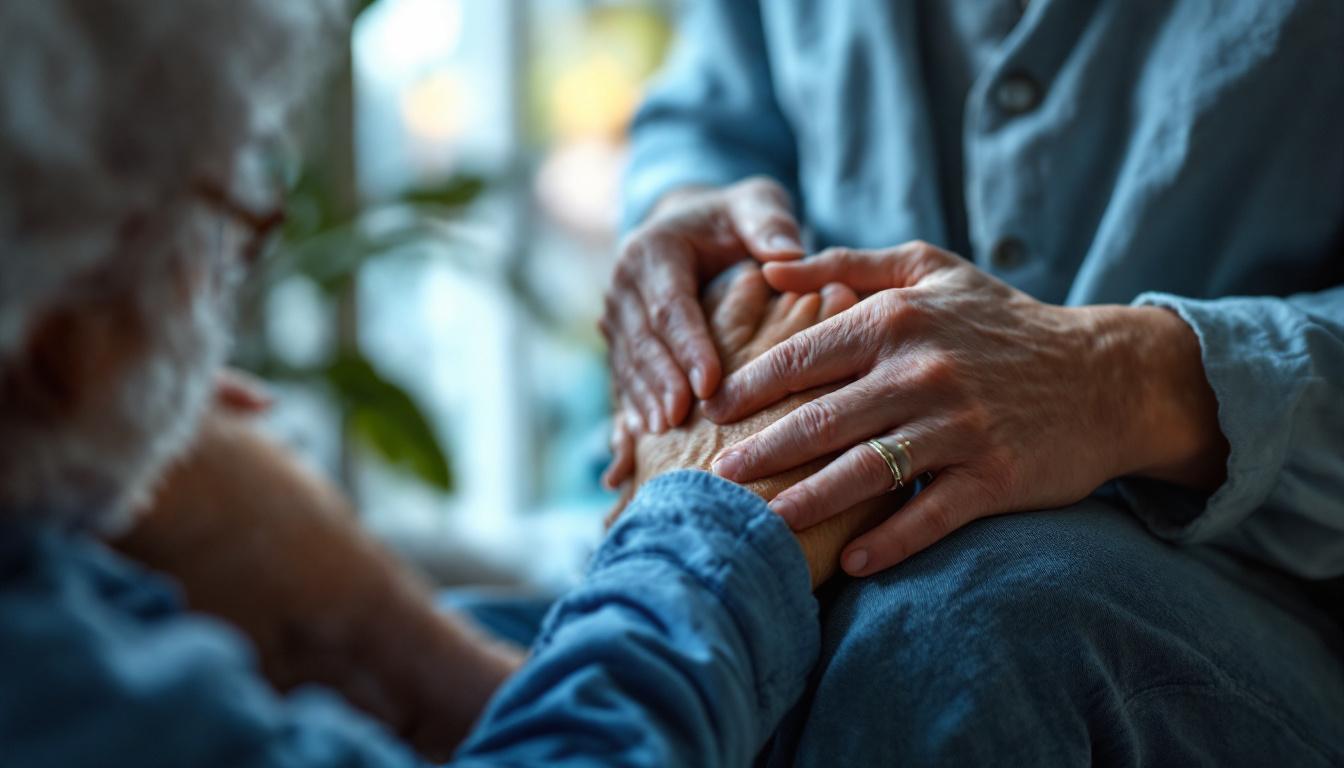Home Remedies for Knee Pain in Old Age (82 years)
Discover effective home remedies for soothing knee pain in old age (82 years). Say goodbye to discomfort with natural solutions.

Understanding Knee Pain in Older Adults
Knee pain is a common complaint that affects people of all ages, including older adults. It can be caused by various factors, ranging from injuries to medical conditions. Understanding the causes and risk factors associated with knee pain is essential for effective management and finding suitable home remedies.

Causes of Knee Pain
Knee pain in older adults can be attributed to several factors. These include:
- Injuries: Knee pain may result from injuries such as ligament tears, meniscus tears, or fractures. Common knee injuries in older adults include ACL (anterior cruciate ligament) injuries and torn meniscus.
- Mechanical Problems: Structural issues within the knee joint, such as loose bodies or dislocated kneecaps, can lead to knee pain. Mechanical problems can interfere with normal knee function and cause discomfort.
- Arthritis: Various types of arthritis, including osteoarthritis, rheumatoid arthritis, and gout, can contribute to knee pain. Osteoarthritis, in particular, is a common cause of knee pain in older adults. It occurs due to the breakdown of cartilage in the knee joint and can result in pain, stiffness, and reduced mobility.
- Infections: In rare cases, knee pain may be caused by infections, such as septic arthritis. These infections can lead to inflammation and pain in the knee joint.
Risk Factors for Knee Pain
Several risk factors increase the likelihood of experiencing knee pain in older adults. These include:
- Excess Weight: Carrying excess weight puts additional stress on the knee joints, increasing the risk of knee pain and conditions such as osteoarthritis. Maintaining a healthy weight is crucial for reducing knee pain.
- Lack of Muscle Flexibility and Strength: Weak or tight muscles around the knee joint can contribute to knee pain. It is important to engage in exercises that improve muscle flexibility and strength to support the knees and reduce discomfort.
- Previous Knee Injuries: Individuals who have experienced previous knee injuries, such as ligament tears or fractures, may be more prone to knee pain in the future.
Understanding the causes and risk factors associated with knee pain in older adults is crucial for effective prevention and management strategies. By addressing these factors and implementing appropriate measures, individuals can alleviate knee pain, improve mobility, and enhance their overall quality of life.
Prevention and Management Strategies
When it comes to managing knee pain in older adults, there are several strategies that can help alleviate discomfort and improve overall knee health. These strategies include exercise, weight management, and the use of medications and supplements.
Exercise for Knee Pain
Exercise plays a crucial role in managing knee pain in older adults. It helps strengthen the muscles around the knee joint, improves flexibility, and reduces stiffness. Engaging in regular exercise can also promote overall joint health and reduce the risk of further knee damage.
There are various types of exercises that can be beneficial for knee pain, including low-impact activities such as walking, swimming, and cycling. These exercises help improve cardiovascular fitness without putting excessive strain on the knees. Additionally, strength training exercises that target the muscles around the knee, such as leg presses and squats, can help provide stability and support for the joint.
It's important to consult with a healthcare professional or physical therapist before starting any exercise program for knee pain. They can provide guidance on appropriate exercises and help develop a personalized exercise plan based on individual needs and abilities.
Weight Management and its Impact
Weight management is a crucial aspect of knee pain prevention and management, especially in older adults. Excess weight puts additional pressure on the knee joints, exacerbating pain and increasing the risk of further damage. In fact, research suggests that for every additional pound of weight, the knee joints experience an extra 4 pounds of pressure during daily activities.
Losing weight can significantly reduce knee pain and improve overall knee health. A balanced and nutritious diet, such as the Mediterranean-style diet recommended by the Arthritis Foundation, can support weight loss efforts while providing essential nutrients for joint health. Making healthy food choices and maintaining a calorie deficit can contribute to sustainable weight loss and alleviate knee pain caused by excess weight.
Medications and Supplements
In some cases, medications and supplements may be recommended to manage knee pain in older adults. Non-steroidal anti-inflammatory drugs (NSAIDs) such as ibuprofen and naproxen can help reduce inflammation and relieve pain associated with arthritis. However, it's important to consult with a healthcare professional before starting any medication, as they can provide guidance on appropriate dosage and potential side effects.
Additionally, some supplements may offer potential benefits for knee pain management. Glucosamine and chondroitin sulfate are commonly used supplements that may help improve joint health and reduce pain in some individuals. However, the efficacy of these supplements varies, and it's important to discuss their use with a healthcare professional before starting any regimen.
When it comes to managing knee pain in older adults, a comprehensive approach that includes exercise, weight management, and appropriate medication or supplementation can help alleviate discomfort and improve overall knee health. It's essential to consult with healthcare professionals to develop a personalized plan that takes into account individual needs and conditions.
Home Remedies for Knee Pain
When it comes to managing knee pain, especially in older adults, there are various home remedies that can provide relief and promote overall well-being. In this section, we will explore three effective home remedies: heat and cold therapy, herbal remedies, and acupuncture and massage therapy.
Heat and Cold Therapy
Heat and cold therapy are simple yet effective methods for alleviating knee pain. Heat therapy using a heating pad or warm compress can help relieve pain and stiffness while promoting relaxation and improved blood circulation. It is particularly beneficial when resting or experiencing muscle tension. On the other hand, cold treatment, such as applying ice packs or using cold compresses, can help reduce inflammation and swelling in the knee joint. It is especially useful after physical activity or to numb acute pain.

Herbal Remedies for Knee Pain
Certain herbs have been found to offer relief from knee pain. Here are a few herbal remedies that have shown promising results:
- Boswellia serrata (Frankincense): Boswellia serrata has been shown to improve knee osteoarthritis symptoms by reducing pain and stiffness. Studies have demonstrated significant improvement in pain and functionality scores in patients receiving oral Boswellia extract compared to placebo [5].
- Curcuma (Turmeric): Curcuma, commonly known as turmeric, possesses anti-inflammatory and antioxidant effects. Clinical trials have shown that Curcuma extracts and curcumin significantly improved pain and functionality scores in knee osteoarthritis patients [5].
- Eremostachys laciniata: Eremostachys laciniata is an herb that has been traditionally used for pain relief. While research on its specific effects on knee pain is limited, it has shown potential as an herbal remedy for managing pain and inflammation.
- Eucommia ulmoides: Eucommia ulmoides is another herb that has been traditionally used for its analgesic and anti-inflammatory properties. However, further research is needed to determine its efficacy specifically for knee pain relief.
- Zingiber officinale (Ginger): Ginger has anti-inflammatory properties and has been associated with reducing knee pain and improving functionality in osteoarthritis patients. Clinical trials have shown that ginger extract was effective in reducing pain, stiffness, and improving physical function in knee osteoarthritis patients.
Acupuncture and Massage Therapy
Acupuncture and massage therapy are alternative treatments that have shown promise in managing knee pain. Acupuncture involves the insertion of thin needles into specific points on the body to stimulate the flow of energy and alleviate pain. A study involving individuals with osteoarthritis in the knee found that true acupuncture resulted in higher pain and functionality scores compared to other treatments. Massage therapy, on the other hand, involves manipulating the soft tissues of the body to promote relaxation and relieve muscle tension. Massaging the knee area with certain oils or ointments containing ingredients like ginger and cinnamon has shown positive effects on pain and functionality in individuals with knee pain.
It's important to note that while these home remedies can provide relief, they may not be a substitute for medical advice. If knee pain persists or worsens, it's recommended to consult a healthcare professional for proper diagnosis and treatment options.
Lifestyle Changes for Knee Pain Relief
When it comes to managing knee pain, making certain lifestyle changes can significantly contribute to pain relief and improve overall quality of life. In particular, focusing on diet and weight loss, muscle strengthening, and engaging in regular physical activity can be beneficial for individuals experiencing knee pain, especially in older age.
Diet and Weight Loss
Maintaining a healthy diet and managing weight are essential factors in alleviating knee pain. Excess weight puts additional pressure on the knee joints, with each extra pound of weight adding about 4 pounds of pressure on the knees [6]. Overweight and obesity can exacerbate knee pain, as an additional 10 pounds of weight can add between 15 and 50 pounds of pressure to a joint, contributing to increased symptoms.
Losing weight can significantly slow the progression of arthritis and alleviate knee pain. A 10-pound weight loss can have a positive impact on knee pain relief [6]. By reducing pressure on the joints, managing weight can help relieve knee pain and improve overall joint health.
Importance of Muscle Strengthening
Proper muscle strengthening is crucial for individuals experiencing knee pain. Strengthening the muscles around the knee joint helps provide support and stability, reducing the strain on the joint itself. Strong muscles can help absorb shock and minimize the impact on the knees during daily activities.
Exercises that target the quadriceps, hamstrings, and calf muscles are particularly beneficial for knee pain relief. These exercises can include leg presses, squats, lunges, and leg curls. It's important to start with low-impact exercises and gradually increase the intensity and duration as tolerated.
Working with a physical therapist or an exercise specialist can help develop a customized strength training program that suits individual needs and limitations. They can guide individuals through proper form and technique to maximize the benefits of muscle strengthening exercises.
Impact of Physical Activity
Engaging in regular physical activity is essential for managing knee pain and improving overall joint health. Contrary to popular belief, physical activity is not detrimental to knee health. In fact, studies have shown that exercise can reduce joint pain, improve physical function, and enhance overall well-being for individuals with knee osteoarthritis.
Low-impact exercises such as walking, swimming, cycling, and water aerobics are excellent choices for individuals with knee pain. These activities provide cardiovascular benefits and help maintain joint flexibility without putting excessive stress on the knees.
It's important to note that individuals with knee pain should start slowly and gradually increase the intensity and duration of exercise. Listening to the body and avoiding activities that cause pain or discomfort is crucial. If necessary, consulting with a healthcare professional or physical therapist can provide guidance on suitable exercises and modifications.
By incorporating these lifestyle changes, individuals can experience significant relief from knee pain. A healthy diet and weight management, along with muscle strengthening exercises and regular physical activity, can contribute to improved knee joint health and overall well-being. It's important to remember that individualized approaches and professional guidance may be necessary to ensure safe and effective implementation of these lifestyle changes.
Specific Herbal Remedies for Knee Pain
When it comes to managing knee pain, several herbal remedies have shown promise in providing relief. These remedies, when used in conjunction with other management strategies, can help alleviate discomfort and improve the overall well-being of individuals experiencing knee pain.
Boswellia serrata (Frankincense)
Boswellia serrata, commonly known as frankincense, has been recognized for its potential to improve knee osteoarthritis (OA) symptoms. Studies have demonstrated that oral Boswellia extract can effectively reduce pain and stiffness in OA patients. Patients receiving Boswellia extract reported significant improvement in Visual Analog Scale (VAS), Japanese Knee Osteoarthritis Measure (JKOM), and Western Ontario and McMaster Universities Osteoarthritis Index (WOMAC) scores compared to those receiving a placebo.
Curcuma (Turmeric)
Curcuma, more commonly known as turmeric, is renowned for its anti-inflammatory and antioxidant effects. Research has shown that extracts of Curcuma and its active compound, curcumin, can significantly improve WOMAC scores in knee OA patients. Notably, these improvements were achieved with better safety profiles and fewer adverse effects compared to diclofenac, a commonly used nonsteroidal anti-inflammatory drug.
Eremostachys laciniata
Eremostachys laciniata is an herb that has been traditionally used in some cultures for its potential anti-inflammatory properties. While further scientific research is needed to establish its efficacy, some preliminary studies suggest that Eremostachys laciniata may hold promise in managing knee pain. It is important to consult with a healthcare professional or herbalist before using this herb for knee pain relief.
Eucommia Ulmoides
Eucommia Ulmoides is an herb that has been used in traditional Chinese medicine. Studies have indicated that Eucommia ulmoides possesses anti-inflammatory properties and may be beneficial in managing knee pain. However, more research is needed to fully understand its potential effects and determine appropriate dosages for knee pain relief.
Zingiber officinale (Ginger)
Zingiber officinale, commonly known as ginger, has long been recognized for its anti-inflammatory properties. Clinical trials have shown that ginger extract can be effective in reducing knee pain and stiffness, improving physical function, and enhancing patient global assessments in knee OA patients. Incorporating ginger into your diet or consuming ginger extracts may help alleviate knee pain and improve overall joint health.
While herbal remedies can offer natural alternatives for knee pain management, it is essential to consult with a healthcare professional before incorporating them into your routine. They can provide guidance on appropriate dosages, potential interactions with medications, and any contraindications based on your individual health status. Additionally, herbal remedies should complement other management strategies such as exercise, weight management, and medication under the supervision of a healthcare professional.
Exercise for Knee Pain Management
Regular exercise plays a vital role in managing knee pain, especially in older adults. Engaging in targeted exercises can help reduce pain, improve physical function, and enhance overall quality of life. In this section, we will explore the benefits of exercise for knee pain management, different types of exercises that can be beneficial, and exercise interventions that can help prevent falls.
Benefits of Exercise
Numerous studies have shown that exercise can have significant benefits for individuals with knee pain, including osteoarthritis (OA). Exercise intervention studies consistently demonstrate a decrease in pain and improvement in function for individuals with OA. Exercise is recommended to reduce joint pain and improve physical function for people with chronic knee and hip joint pain from osteoarthritis. The benefits of exercise include:
- Reduction in pain: Exercise has been shown to reduce pain levels in individuals with chronic hip and knee pain, leading to improved quality of life.
- Improvement in physical function: Regular exercise can enhance physical function, allowing individuals to perform daily activities with greater ease and mobility.
- Increase in self-efficacy: Exercise can boost self-efficacy, the belief in one's ability to successfully engage in activities, leading to greater confidence in managing knee pain.
- Improvement in mental well-being: Exercise has been associated with a reduction in depression symptoms, contributing to overall mental well-being.
Types of Exercise for Knee Pain
Different types of exercises can be beneficial for managing knee pain. It's important to choose exercises that are suitable for your individual needs and capabilities. Here are some common types of exercises recommended for knee pain management:
- Range of motion exercises: These exercises focus on improving joint flexibility and mobility. Examples include knee bends, leg raises, and heel slides.
- Strengthening exercises: Strengthening the muscles around the knee can provide added support and stability. Exercises like squats, lunges, and leg presses can help build strength in the quadriceps, hamstrings, and calf muscles.
- Low-impact aerobic exercises: Engaging in low-impact activities like swimming, cycling, or using an elliptical machine can help improve cardiovascular fitness without placing excessive stress on the knees.
- Balance and stability exercises: These exercises aim to enhance balance and reduce the risk of falls. Examples include standing on one leg, heel-to-toe walk, and tai chi.
- Water-based exercises: Water-based activities, such as water aerobics or swimming, provide a low-impact environment that can be gentle on the joints while still providing a beneficial workout.
Exercise Interventions and Falls Prevention
Exercise interventions have shown promising results in reducing the risk of falls among older individuals. In a study including 108 randomized controlled trials with over 23,000 participants, exercise (all types) was found to reduce the rate of falls by 23% and the number of people experiencing one or more falls by 15%. These findings highlight the importance of exercise in falls prevention for older adults.
By incorporating exercises that improve strength, balance, and flexibility into your routine, you can help reduce the risk of falls and maintain better overall knee health. It's important to consult with a healthcare professional or a physical therapist before starting any exercise program to ensure that the exercises are suitable for your specific condition and needs.
Regular exercise, when done correctly and under proper guidance, can be an effective and natural way to manage knee pain in older adults. By reaping the benefits of exercise and engaging in appropriate exercise interventions, individuals can experience improved pain management, enhanced physical function, and a better quality of life.
References
- [1]: https://www.mayoclinic.org/diseases-conditions/knee-pain/symptoms-causes/syc-20350849
- [2]: https://www.ncbi.nlm.nih.gov/pmc/articles/PMC4596631/
- [3]: https://www.healthline.com/health/pain-relief/knee-pain-home-remedies
- [4]: https://www.medicalnewstoday.com/articles/311280
- [5]: https://www.ncbi.nlm.nih.gov/pmc/articles/PMC7693010/
- [6]: https://www.webmd.com/healthy-aging/features/knee-pain-aging
- [7]: https://www.ncbi.nlm.nih.gov/pmc/articles/PMC6494515/
- [8]: https://www.ncbi.nlm.nih.gov/pmc/articles/PMC6360922/




































































































